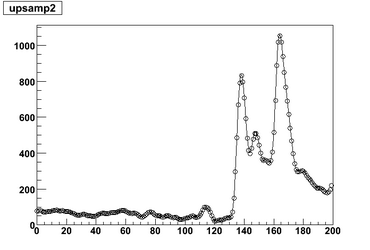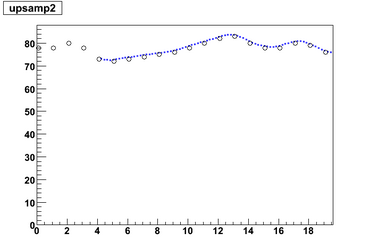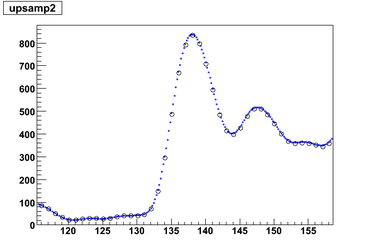CDC algo
From GlueXWiki
Contents
CDC time & integral algorithm
We will need to arrange the trigger timing so that when the trigger signal arrives, the presample buffer contains a number of samples for pedestal followed by the earliest possible CDC sample and then another 155 samples (for maximum drift time).
Quantities to be returned, if a hit is found
- Leading edge time (11 bits, units of sample/10)
- Time quality factor (1 bit) set to 0 if time is good, 1 if time is rough estimate
- Pedestal immediately before the hit (8 bits, set to 255 if >254)
- Signal integral (n bits, scaled down by factor 2^m; n,m approx 14,4, TBC)
- Signal maximum (p bits, scaled down by factor 2^q; p,q approx 9,3, TBC) this is the first maximum in the signal after the threshold crossing
- Overflow count (3 bits, set to 7 if >6)
Configuration constants (all values are integers, σ=pedestal width ~16)
- window_start: start of hit search window as sample number relative to the trigger arrival, this is the earliest possible hit time
- window_end: end of hit search window as sample number relative to the trigger arrival, approx 155 samples after window_start
- hit_threshold: threshold to identify hit (default 5σ ~80, range 50 to 300)
- high_threshold: High timing threshold (default 4σ ~ 64, range 40 to 270) must be lower than hit threshold
- low_threshold: Low timing threshold (default 1σ ~ 16, range 5 to 30)
- nsamples: number of ADC samples to pass to time finding module (default 14)
- xthr_sample: sample number containing first sample (x) above hit_threshold (default 8)
- ped_sample: sample number to be used as local pedestal (default 4)
- rough_dt: if timing fails because ADC values do not exceed high_threshold, return hit time of xthr_sample-rough_dt (default 20, units sample/10)
- integral_offset: number of samples before x to include in integration (default 3).
Hit finding module
- Wake up on trigger
- Calculate start_pedestal as mean of 4 samples window_start-5 to window_start-1
- Search from window_start to window_end for ADC value rising above start_pedestal + hit_threshold. If not found, go back to sleep. If found, continue.
- Call up time-finding module and send in nsamples ADC values from the hit threshold crossing region, with the threshold-crossing sample x as value number xthr_sample in the sequence (starting at 0)
- Call up signal maximum module
- Call up signal integral module
- Return local_pedestal as value of sample (x + ped_sample - xthr_sample), or 255 if local_pedestal>254
- Return integral and overflow count from integral module
- Return q_code from time module
- Return (x - xthr_sample)*10 + time returned from time module, units are 0.1*sample-period (0.8ns)
Time finding module
This returns an error code q_code and the hit time, relative to the threshold-crossing sample time
- Calculate thresholds from constants and local_pedestal, which is sent in as in sample number ped_sample
- Search the samples from ped_sample+1 to nsamples-1 for value >= high_threshold + local_pedestal. If this threshold is not exceeded, return bit q_code=1 and time x*10-rough_dt
- Search back from high_threshold crossing down toward ped_sample to find sample y where value <= low_threshold + local_pedestal
- Calculate 7 upsampled values, from y-0.2 to y+1.2
- Search the upsampled values from y+1.2 down to y-0.2 to find where the value <= low_threshold + local_pedestal
- Interpolate between the upsampled value just found and the next to find the crossing time in units of sample/10
- Return crossing time found and q_code=0
Signal maximum module
This returns the signal maximum
- Inspect ADC values after sample x, find the first value which is less than its predecessor
- Return value of the predecessor scaled down by 2^p
Signal integral module
This returns the signal integral and overflow count
- Sum signal-local_pedestal, from sample x-integral_offset to sample end_window, and count the number of samples with overflow bit set
- Return integral scaled down by 2^m (return all bits set if value exceeds that of bits available)
- Return overflow count (return 7 if count>6)


